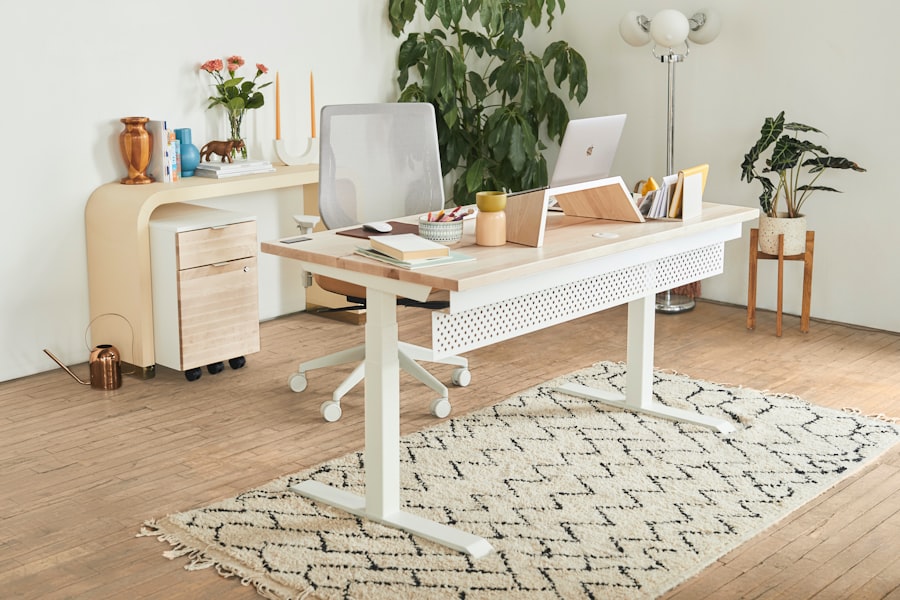Creating an effective workspace begins with a thorough understanding of your specific needs. Every individual has unique requirements based on their work style, the nature of their tasks, and personal preferences. For instance, someone who spends long hours on the computer may prioritize comfort and ergonomics, while a creative professional might need a more flexible and inspiring environment.
Assessing your daily activities can help you identify what elements are essential for your workspace. Consider factors such as the type of work you do, the tools you use, and how much space you require for movement and organization. This initial evaluation will serve as a foundation for making informed decisions about your office furniture.
Moreover, it is crucial to think about the layout of your workspace. The arrangement of furniture can significantly impact productivity and comfort. For example, if you frequently collaborate with colleagues, an open layout with easily movable furniture may be beneficial.
Conversely, if your work demands concentration and minimal distractions, a more enclosed setup might be preferable. Additionally, consider the technological aspects of your workspace, such as the need for power outlets, cable management solutions, and adequate lighting. By taking the time to understand your workspace needs comprehensively, you can create an environment that not only enhances productivity but also promotes well-being.
Key Takeaways
- Understand your specific workspace needs before selecting office furniture
- Consider ergonomic factors such as adjustable height and lumbar support when choosing office chairs
- Find a desk that suits your work style, whether it’s a standing desk or a traditional sit-down desk
- Assess the comfort and support of office chairs, including cushioning and armrests
- Select office furniture made from durable and sustainable materials for longevity and environmental impact
Ergonomic Considerations for Office Chairs
Key Features of an Ergonomic Office Chair
When selecting an office chair, it is essential to prioritize ergonomic considerations to ensure a comfortable and healthy working experience. An ergonomic chair is designed to support the natural posture of the body, reducing strain on the spine and promoting overall comfort during long hours of sitting. Key features to look for include adjustable seat height, lumbar support, and armrests that can be modified to suit your body type.
The Importance of Adjustability and Customization
A chair that allows for adjustments ensures that you can customize it to fit your unique shape and size, which is essential for maintaining proper posture and preventing discomfort or injury. This level of customization is crucial in creating a comfortable working environment that caters to your individual needs.
Additional Factors to Consider
In addition to adjustability, the material and design of the chair play a significant role in its ergonomic effectiveness. Breathable fabrics can help regulate temperature and prevent sweating during extended use, while cushioned seats provide additional comfort. Furthermore, the chair’s mobility is another important factor; a swivel base and smooth-rolling casters can enhance your ability to move around your workspace without straining.
Creating a Healthier Work Environment
By prioritizing ergonomic features in your office chair selection, you can create a healthier work environment that minimizes physical stress and enhances productivity. This, in turn, can lead to improved overall well-being and a more efficient working experience.
Finding the Right Desk for Your Work Style
Choosing the right desk is equally important as selecting an ergonomic chair, as it serves as the central hub for your work activities. The ideal desk should align with your work style and accommodate the tools you use daily. For instance, if you often work with multiple monitors or require extensive writing space, a larger desk with ample surface area may be necessary.
Alternatively, if you prefer a minimalist approach or have limited space, a compact desk with built-in storage solutions could be more suitable. Understanding how you interact with your workspace will guide you in selecting a desk that meets your functional requirements. Additionally, consider the height of the desk in relation to your chair and overall posture.
A desk that is too high or too low can lead to discomfort and strain over time. Height-adjustable desks have gained popularity in recent years as they allow users to alternate between sitting and standing positions throughout the day. This flexibility can promote better circulation and reduce fatigue.
Furthermore, think about the desk’s design and how it fits into your overall workspace aesthetic. A well-chosen desk not only enhances functionality but also contributes to a cohesive and inspiring work environment.
Assessing Comfort and Support in Office Chairs
Comfort and support are paramount when evaluating office chairs, as they directly influence your ability to focus and perform tasks efficiently. A chair that provides adequate support for your back is essential for maintaining good posture and preventing long-term health issues. Look for chairs with adjustable lumbar support that can be positioned to fit the curve of your lower back.
This feature helps alleviate pressure on the spine and encourages a more natural sitting position. Additionally, consider the seat depth and width; a chair that is too shallow or narrow can lead to discomfort during extended periods of use. Another critical aspect of comfort is cushioning.
The right amount of padding can make a significant difference in how comfortable you feel throughout the day. However, it’s essential to strike a balance; overly soft cushions may lead to poor posture, while excessively firm seats can cause discomfort. Testing various chairs in person can help you determine which level of firmness works best for you.
Furthermore, consider how well the chair accommodates movement; a design that allows for slight rocking or shifting can promote better circulation and reduce stiffness during long hours of sitting.
Selecting the Right Materials for Office Furniture
The materials used in office furniture play a crucial role in both durability and aesthetics. When selecting office chairs and desks, consider materials that not only withstand daily wear and tear but also contribute to a comfortable working environment. For instance, high-quality fabrics or leather can enhance the look of an office chair while providing comfort and ease of maintenance.
Similarly, desks made from solid wood or high-grade laminates offer durability and stability, ensuring they can support heavy equipment without warping or bending over time. In addition to durability, the choice of materials can also impact the overall ambiance of your workspace. Natural materials like wood can create a warm and inviting atmosphere, while metal finishes may lend a more modern or industrial feel.
It’s essential to choose materials that resonate with your personal style while also considering how they fit into the broader design of your office space. Furthermore, sustainability is becoming increasingly important; opting for eco-friendly materials not only benefits the environment but can also enhance your brand image if you work in a client-facing role.
Maximizing Functionality and Storage in Desks
Optimizing Desk Storage for Enhanced Productivity
When choosing a desk, functionality is a crucial factor to consider, particularly in terms of storage options. A well-designed desk should provide ample space for all necessary tools while keeping clutter at bay. Look for desks that incorporate built-in drawers or shelves to store office supplies, documents, and personal items conveniently.
Customization and Adaptability for Evolving Needs
This organization not only enhances productivity but also contributes to a more visually appealing workspace by minimizing distractions caused by disarray. Consider desks with modular designs that allow for customization based on your evolving needs. Some desks come with detachable components or add-ons that enable you to expand storage capacity or adjust workspace layout as required.
Streamlining Workspace with Cable Management Solutions
This adaptability is particularly beneficial in dynamic work environments where tasks may change frequently. Integrating cable management solutions into your desk design can help keep cords organized and out of sight, further enhancing functionality while maintaining a clean aesthetic.
Considering Aesthetics and Style in Office Furniture
While functionality is critical in office furniture selection, aesthetics should not be overlooked. The visual appeal of your workspace can significantly influence your mood and motivation levels throughout the day. When choosing office chairs and desks, consider how their design complements your personal style as well as the overall theme of your office environment.
Whether you prefer sleek modern lines or classic traditional designs, selecting furniture that resonates with you can create an inspiring atmosphere conducive to creativity and productivity. Furthermore, color plays an essential role in setting the tone of your workspace. Bright colors may energize and stimulate creativity, while neutral tones can promote calmness and focus.
Incorporating decorative elements such as artwork or plants can also enhance the aesthetic appeal of your office while contributing to a more inviting atmosphere. Ultimately, finding a balance between functionality and style will result in a workspace that not only meets practical needs but also reflects your personality and fosters a positive working environment.
Budgeting and Sourcing the Best Office Chairs and Desks
Budgeting is an integral part of selecting office furniture that meets both quality standards and personal preferences. Establishing a clear budget allows you to narrow down options without compromising on essential features such as ergonomics or durability. It’s important to remember that investing in high-quality office chairs and desks can lead to long-term benefits in terms of comfort and productivity; therefore, it may be worth allocating more funds toward these items rather than opting for cheaper alternatives that may not last as long.
When sourcing office furniture, consider various avenues such as online retailers, local showrooms, or second-hand options to find the best deals without sacrificing quality. Online marketplaces often provide extensive selections at competitive prices; however, it’s crucial to read reviews and check return policies before making purchases. Local showrooms allow you to test furniture in person before buying, ensuring that you find pieces that meet your comfort requirements.
Additionally, exploring second-hand options can yield unique finds at lower prices while promoting sustainability through reuse. By carefully budgeting and sourcing wisely, you can create an efficient workspace tailored to your needs without overspending.
If you’re looking to upgrade your office furniture, you might be interested in exploring some stylish office chair options to complement your workspace. A great resource for this is an article that reviews various office chairs available in Dubai. You can find a selection of chairs that not only prioritize comfort but also enhance the aesthetic appeal of your office. Check out the article on stylish office chairs by visiting Stylish Office Chairs in Dubai to discover the perfect chair that meets your needs and preferences.
FAQs
What are the different types of office chairs?
There are several types of office chairs, including ergonomic chairs, executive chairs, task chairs, and conference chairs. Each type is designed for specific purposes and offers different features and levels of comfort.
What features should I look for in an office chair?
When choosing an office chair, it’s important to consider features such as adjustable seat height, lumbar support, armrests, and swivel and tilt mechanisms. These features can help promote good posture and reduce the risk of discomfort or injury.
What are the benefits of using an ergonomic office chair?
Ergonomic office chairs are designed to provide support and comfort, promoting good posture and reducing the risk of musculoskeletal issues. They often feature adjustable components to accommodate individual preferences and needs.
What are the different types of office desks?
Office desks come in various types, including executive desks, standing desks, L-shaped desks, and adjustable-height desks. Each type offers different features and benefits to accommodate different work styles and preferences.
What factors should I consider when choosing an office desk?
When selecting an office desk, it’s important to consider factors such as size, shape, material, storage options, and ergonomic features. These factors can impact the functionality and comfort of the workspace.
How can I create an ergonomic office setup with chairs and desks?
To create an ergonomic office setup, it’s important to choose chairs and desks that promote good posture and provide adequate support. This may include adjusting the height of the chair and desk, using a footrest, and positioning computer monitors at eye level.




